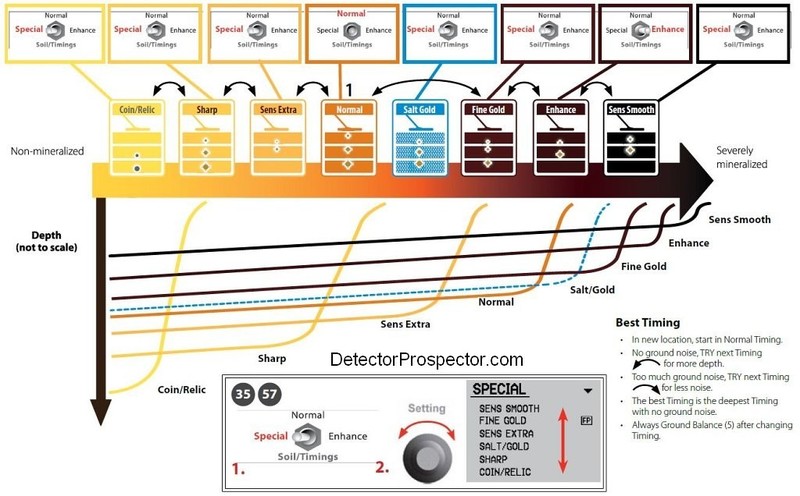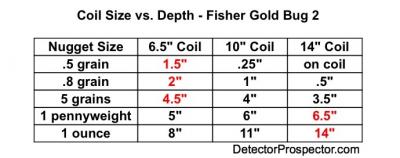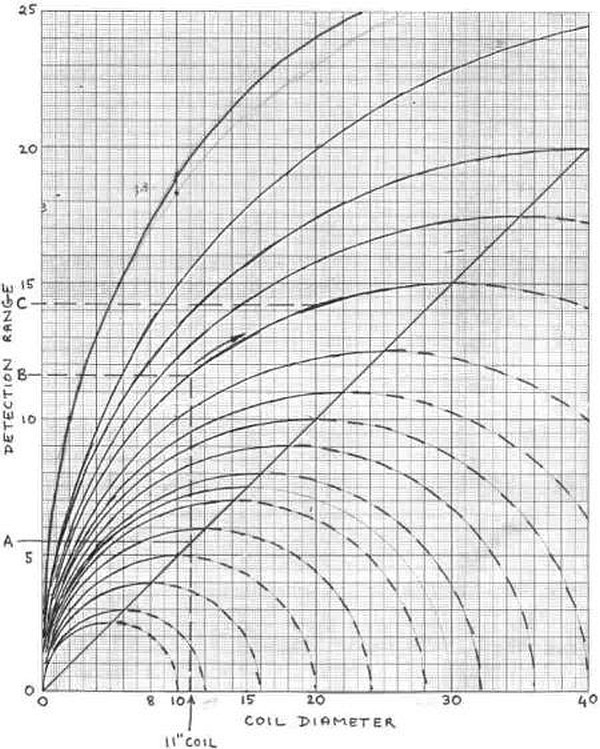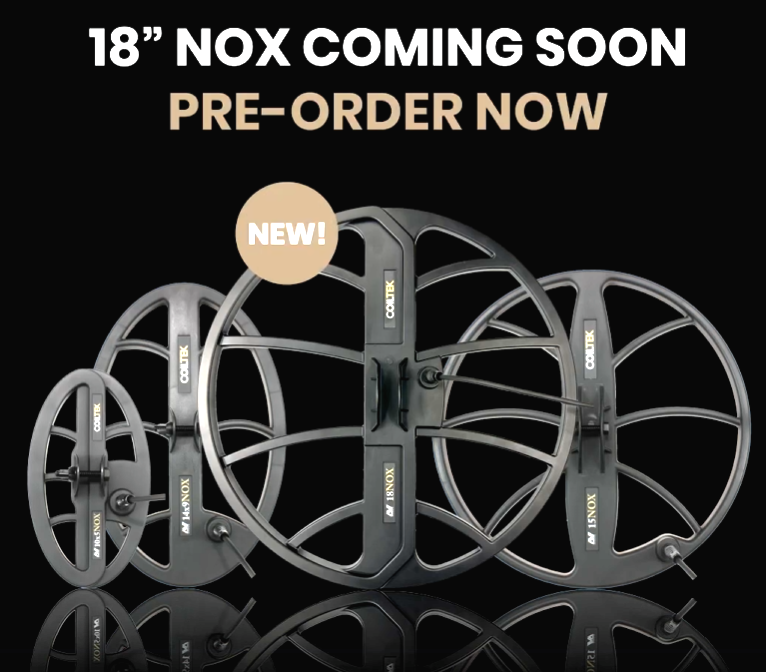-
Posts
19,808 -
Joined
Content Type
Forums
Detector Prospector Home
Detector Database
Downloads
Everything posted by Steve Herschbach
-
I say it is your decision to make. They are both capable machines. They are very similar in performance yet very different in ways that should make a decision easy. In GPX 5000 you have a detector with a multitude of settings and coil options for people that thrive on complexity. It is the better machine for using very large coils for long hours with its balanced harness and bungee system. The Axiom is a far easier detector to master by comparison and favors those who prefer an all in one package. In general it’s better used with medium to smaller coils. Simply look at both machines and the features they offer, and I highly suggest you look at both operating manuals. I would hazard a guess that many GPX 5000 owners never really mastered all the setting interactions. They just found a few settings that worked or were suggested on the internet and stuck with those. But that same complexity also means an ability to adjust for a wide range of conditions and targets. The Axiom on the other hand has a more limited set of controls, but you are also less likely to be lost in the weeds and perhaps running settings wholly inappropriate to the situation. Only you can decide which system better suits you. It can be noted that even Minelab decided the 5000 had gotten too complex for many people, and they went 180 degrees with both the 7000 and 6000 in that regard. https://www.detectorprospector.com/magazine/steves-guides/minelab-gpx-4000-4500-5000-manuals-timing-charts/ GPX 5000 Quick Start Tutorial Garrett Axiom Quick Start Tutorial
- 21 replies
-
- relic detecting
- garrett axiom
-
(and 1 more)
Tagged with:
-
Keeping to your original question - Axiom or GPX 5000 - you may be better served by the GPX 5000 in your case due to the superior coil selection. If you are looking for larger than coin size objects like that pot of coins, something like an 18" Nugget Finder mono on a GPX 5000 would have an edge over the Axiom 14x16 mono, currently the largest Axiom coil available. You seem skeptical of the Axiom anyway so why bother? Other than ergonomics and sensitivity to small targets there is no particular reason to go Axiom over the GPX 5000.
- 21 replies
-
- relic detecting
- garrett axiom
-
(and 1 more)
Tagged with:
-
There are plenty of things one can learn from contrived tests including air tests. I do them myself. They are not without value…. if viewed by people who understand what they are seeing, and who understand the limitations. What I find objectionable are the elevation of these types of tests as being the final word on things when they are not. There have been a lot of detectors that did great in the lab but ended up not seeing the light of day because they failed in real world situations, way more than people know about.
-
Two thumbs up for mixed mode and tones only! I guess it comes down to the difference between those that see the audio feedback as noise and those of us who hear the machine talking to us. I hate gagging my little buddy since he might not tell me something I want to know. The Excalibur was deadly because it had no meter and so forced the user to learn full tone detecting. The 17 tones soon meld into a few, with that sweet jewelry tone stopping the experienced hunters up short. Unfortunately it and its users were too good, and they cleaned out a lot of what was out there before it came along.
-
So what sells metal detectors these days? A lot of the market now is driven by “influencers” on YouTube and other social media. There is no requirement that the person involved have any genuine knowledge about what they are talking about. All that matters, and I mean all that matters, is how big their viewership is. That’s the way the media works these days. Truth, accuracy, etc. are completely secondary to how many eyeballs you can draw. In fact you can have a show or channel about complete BS and as long as you can draw viewers in large numbers, you are golden. Metal detector video by nature tends to rely on contrived tests. The most widely seen is perhaps the Monte Nail Board test. But there are endless variations of tests using wood blocks and styrofoam blocks, you name it. These all remove the most important thing about a detector - how well does it separate the target from the ground? Ground conditions (wet, dry, salty, 3D trash density) and magnetic mineralization rule everything from depth to target id accuracy. But that does not matter. What is important is it is popular and people believe it. So the manufacturers do now pay attention to producing detectors that perform well in these videos, and if performing well in the videos means maybe not so well in the ground at the end of the day you do what you need to do to sell metal detectors. Thats job one - sell metal detectors. This reliance on these types of tests and the people who do them go a long way to explaining why recent detectors do well with the YouTubers but not so well with the people that really use them. This forum tends to downplay contrived tests in favor of actual in field use on actual found targets, by expert users. The answers often are nuanced and lack the clear quick black and white the marketers need to sell the product. Finding the truth on the Manticore means reading 100 posts or more on the subject by a wide number of different real world users in different locations. The truth emerges over time, not in a five minute video shot by a guy who has had the detector for three days, if that. To sum up though it all comes back to how important it has become to do well in air tests and the Monte test, with actual stable performance in the ground being a secondary factor. And unfortunately a detector jacked up to do well in the air does not often do all that well in the ground. I relayed this story before. I was at my Moore Creek Mine in Alaska, and a visitor arrived with a Fisher 71 kHz Gold Bug 2. I was swinging a Fisher 13 kHz F75 at the time. He thought I was an idiot as he knew for a fact his Gold Bug 2 did better on gold than the F75. Now mind you, the goal at Moore Creek was 1/4 ounce and larger nuggets. Those were daily finds with 1-3 ounce nuggets common. He was pretty adamant so I said “here, let me show you something.” We took a 1/4 ounce nugget and air tested both machines. The Gold Bug 2 easily trounced the F75 and I could see the smirk on his face from the result. Then we buried the nugget in the ground. The F75 easily hit the nugget beyond the point where the Gold Bug 2 would even signal at all, and not by a thin margin. The guy was astounded. But he simply did not know that high frequencies air test well but fall on their face for penetration in bad ground on larger targets compared to lower frequency detectors. The same error is made repeatedly with PI detectors, either testing them against VLF detectors in the air or in low mineral ground. PI basically exists as a solution for extreme conditions, and testing them outside those extreme conditions is not only inaccurate but highly misleading. The same can be said of any this versus that VLF tests that remove the ground from the equation. It’s just not as dramatic as with PI versus VLF, but it is real all the same. When you are spitting hairs like so many people do these days taking ground out of the equation is ridiculous.
-
As one of those old timers let me clarify that. It is not so much depth that is limited but the ability to detect the target, which can be perceived as the same thing. Is there anyone here that does not get jumpy or dancing target id numbers on weak signals, especially those in highly mineralized ground? The problem is that targets often do not have nice tight distinct single number responses. The number varies with how you swing over the target. In effect a target produces a range of possible responses. By limiting those responses you limit the ability to detect the target. Let's say you read that a nickel is 13 on an Equinox. So you block out everything but 13. Well, you go past those oddball nickels that read other that 13 on the first swing. Whether you were limiting the depth on those targets or limiting the ability to find them at all is a fine distinction. Any notch on any number can inadvertently block a desirable signal. One of the finer points of a detector with a wide target spread like the White's V3i was that you could put a notch of a single number on a certain pull tab response. It would not eliminate the tab but cause it to break up, letting you know it was probably a tab with a trashy response while minimizing the overflow/slop dangers of applying, for instance, and range of three or four blocked numbers to cleanly reject the target. Again with most detectors this is most commonly seen with the zinc penny. As it corrodes it produces a wide range of responses. To get rid of all those pesky pennies you have to notch out a range. But that same range can include Indian Head pennies or jewelry items, so how aggressive do you want to get? Every employment of discrimination is nothing more than a gamble, a way to change the odds when dealing with limited time. But rest assured that in mineralized ground almost all targets can occur in such a way as to read ferrous or to shift target id into some other trash reading. This is just gold nugget detecting 101 but it applies as much to every type of detecting there is. Overthinking discrimination is fraught with danger because it is at best a dull tool. So this old timer says not that the more discrimination you employ the more you limit depth, but that the more discrimination you employ to more you increase your odds for leaving good targets in the ground. I rarely ever notch or outright reject anything, preferring to use full tones and simply dig targets that sound good. I'm a fairly proficient cherry picker with a PI detector just by reading the tonal responses. IAR is a way to try and replicate in electronics what a person like me is doing with their ears. Most round targets and most non-ferrous targets produce different signals than most ferrous targets. Not all by a long shot, but enough to sway the odds in your favor.
-

Detech Coils Coming Soon For The Garrett Axiom
Steve Herschbach replied to phrunt's topic in Garrett Metal Detectors
Well, so far this has turned into a great big nothing from Detech. I wonder what happened, but not enough to try and contact them to find out. I'm pretty well done for the winter anyway so waiting for spring anyway. And if nothing by then I'll just keep doing what I do with the 7x11 mono and 13 DD, which are pretty much my go to coils now. 7x11 mono for nugget hunting and 13 DD for beach detecting. I still want a good wading coil. I actually took a 13" mono and gouged out the interior foam and filled with cement crack filler. It was perfect underwater at Tahoe but I completely forgot that the mono coils do not like the intense magnetite at Tahoe, and so that ended up being a fail for my purposes. The prospect of trying to do the same with the internally complicated 13" focused core DD seems to be a bit more than I want to bother with at this point, but if I get bored enough this winter I might give it a go. -

Axiom Vs GPX For Relics???
Steve Herschbach replied to Soky72's topic in Metal Detector Advice & Comparisons
An Axiom update or a new PI from Nokta or Fisher won't change anything. We are near the limits of the tech. People don't want to hear that and many refuse to believe it but that's where we are. If you want more and better finds put more effort into research and finding new places to hunt. That will pay off far more than waiting for an Axiom update or Nokta Super Duper Whiz Bang PI. There is no update to the Axiom that will substantially change how it currently performs. All I expect to see is much like we saw with Axiom - better packaging, better prices. But two more inches of depth? I'm not holding my breath. Maybe it's your 5000 that needs the update. -

Axiom Vs GPX For Relics???
Steve Herschbach replied to Soky72's topic in Metal Detector Advice & Comparisons
I will just comment that with any PI the more mineralized the ground, the less accurate the PI disc. I have seen the GPX models call 1/4 gold nuggets in plain view as ferrous, and similar issues with Axiom. We of course have to use the tools we have as best we can and so I’d rather have the feature than not. But that said I cherry pick based purely on tone myself. PI detectors are like old analog VLFs in that they impart a lot of info through the target audio that is lacking in modern digital VLF detectors, and those with a knack for hunting by ear can do well getting to learn a PI, but it does take some time and patience to build the skill. This was brought home to me this last year. I have hunted some places for gold nuggets by cherry picking basically sweet high tones, and passing on most low tones or broken/raspy high tones. I figured I must have left some large gold behind, which goes low tone. Or specimens which give trashy signals. I did a bunch of dig it all detecting in those areas this summer and was amazed in a bad way at how well I had cherry picked out the gold. I mean like a pound of gold. So now I go back with a dig it all mind set and dig nothing but nails and assorted ferrous junk. It turns out I was remarkably effective at cherry picking targets by tone, far better than I even thought. I really don’t need the ferrous check stuff and tend to forget it’s even an option. Just give me that sweet gold tone. Final thought on the PI disc whether Minelab or Axiom. And yes Minelab can be full time on, Axiom you need to press the button. Setting full time is convenient but also means simply walking over stuff and not knowing it was there. Theory with Axiom is acquire the target first before playing with admittedly lousy PI disc. It works best for areas littered with surface trash. Neither Minelab nor Garrett helps with the targets I need the most help with - the nail at 18”. The Axiom grunts on ferrous targets. If you sweep 10 times and get ten grunts it’s probably ferrous, except in very high mineral ground, where all bets are off. But if you sweep ten times and get nine grunts there is a 10-20% chance it’s non-ferrous. Sweep ten times and only five grunts, 60-80% chance it’s non-ferrous. I am pulling those numbers out of my posterior because the ground messes too much with the odds, but I hope you get the point. Any non-ferrous indication at all should be given high weighting. This versus that? Nothing at all wrong with the Minelabs. More coils, more settings, great detectors. Axiom is just an alternative for those wanting something different and I doubt going from one to the other will change much about what gets found. A good detectorist in a good location should do well with either. -
Each coil size made has an optimum target size that gets max depth. Smaller or larger targets than that optimum will not get as much depth as other coils better optimized for those sizes. The larger the coil, the larger the optimum target size. So a small coil will get more depth on small targets than a large coil. Large coils get more depth on large targets than small coils. So you pick the coil that best fits the size targets you are after. This is VLF but the principle is the same and this chart illustrates it well: Coil Size vs Depth Fisher Gold Bug 2 Source - Field Testing the Gold Bug 2 by Gordon Zahara Eric Foster used a chart he made that showed the same thing in a more technical way for PI detectors. Here is the chart, with details at this thread: As far as specific numbers to your questions the fact is there are too many variables to consider. All I can offer is the above and generalities. Ground mineralization can largely negate depth gains with larger coils depending on the exact circumstances and flatten the results. But in general if you are looking for fist size stuff the largest coil is the way to go. Personally I don't really use the 16" coils because I am usually focused on coin size targets and the larger coils offer minimal if any gains on those, or at least not enough for me to care to swing the extra weight. But if I was looking for a 6 ounce gold nugget I'd put the 16" coil on.
-

Gold Detecting In Scotland
Steve Herschbach replied to mcmichael's topic in Detector Prospector Forum
-

Nfd 90 Metal Detector
Steve Herschbach replied to Sven1's topic in Metal Detector Advice & Comparisons
Either the manufacturer or a manufacturer representative has already been on the forum promoting the product. Yeah, high frequency detectors air test great. I used to do all these surface test tricks with the Gold Bug 2 also but things change fast when you add dirt, and especially moisture. Be sure and throw flat steel into the test, not just nails. -
-
When it comes to devices the Minelab GPZ 7000 pretty much defines the state of the art at this time. Anything that claims to outperform it by so much as a centimeter should be looked at with extreme skepticism. The only other device most genuine individual prospectors might consider is a magnetometer, which only responds to magnetic anomalies. This can be used to indirectly find gold by tracing magnetic minerals. This document is dated but still almost 100% valid to todays technology. You will note LRL devices are glaringly absent. Handbook of Geophysical Prospecting Methods for the Alaskan Prospector A dated but still realistic summary of electronic deices used in the prospecting industry, aimed at the individual prospector. A more recent and technically dense publication that updates the last one: Geophysics For Mineral Exploration - A Manual For Prospectors A more recent publication that updates the one above, read both.
-
Sounds like you are sold. All you have to do is give him $500 and then you can evaluate his information for yourself. Just be aware that the gold business is full of people who will say or do anything to take money from people who are looking for gold. Long Range Locators are the most obvious form of scam, but there are countless schemes out there for taking your money. Anyone can take a few minutes to make maps showing anything you want and I certainly would not be taking their word carte blanche that they know what they are doing. Of course that is what they are saying since they want your money. The problem is so bad that there is an actual definition for who to trust and who to be skeptical of. A person who meets the standards is referred to as a Qualified Person and the standards are discussed here. "A qualified person is defined in the National Instrument as: is an engineer or geoscientist with at least five years of experience in mineral exploration, mine development or operation or mineral project assessment, or any combination of these; has experience relevant to the subject matter of the mineral project and the technical report; and is in good standing with a professional association and, in the case of a foreign association, is of recognized stature within that Organization." If this person is legitimate then he should be willing to provide you with a list of satisfied customers at large mining companies. They will pay a lot more than he is asking you for if his methods are productive. Be aware that even references can be made up and so due diligence is required in investigating them. I guess it just depends how wealthy you are and how much money you can afford to give people in your quest to find gold. I highly recommend people download and read this free publication: Gold From Water (and other mining scams) "While many are attracted to mining because of the potential to obtain riches from rocks, prospecting or investing in mining is an expensive and risky venture. But in this business, there are indeed some valuable ore deposits left to be discovered, so proceed with great care and assistance, if necessary. Be systematic, apply liberal doses of common sense, and control your “gold fever.” If it sounds too good to be true, it probably is."
-

Tesoro Lobo Super-trac Alignment Procedure?
Steve Herschbach replied to Az_Ed's topic in Compass, D-Tex, Tesoro, Etc.
I used the Lobo at my pay to mine operation in Alaska for the reasons stated - easy, all metal operation. We marked the controls with presets and handed them out as loaners for people needing a detector. We also had the Infinium as the PI alternative for the same reason. An Xterra Pro actually costs less, is waterproof, and can be had new with a warranty, and would certainly be my choice over the Lobo these days. I'd vote for the Deus though with a trained operator for an archeology department as perhaps the most successful relic recovery machine ever made. Tens of thousands of European relic hunters use the Deus for a reason. But it keeps coming back to what do you hand a person that knows nothing about running a detector, and the Lobo is still in the running as a device there. Something like a Deus or even an Xterra would need to be set up by a knowledgeable person than handed off with a warning not to mess with the controls. -
Hi Jeff, thanks for stopping in! In case people do not know Jeff was a key player in the V3i - like really key. The V3i was Equinox before Equinox, and I tried to get White’s to understand what they had on their hands. I in fact pretty much described the Equinox by asking that a V3i be reimagined in a simplified pod on rod configuration. The part I miss most is that gorgeous Spectra display, far better than anything Minelab has done in my opinion. Keeping the key ability to customize the display for single and multiple frequency would be good. What could be lost are a lot of settings tweaks and interactions that go way over the head of a lot of people. Ground balance needed improvement. But mainly as far as tuning just stick with the standard stuff. I kind of wish I’d have kept my last V3i but after going back and forth several times decided the DFX gets along better with my Bigfoot coil. The DFX also fills a role with me as a machine that is not so hyped up bloody sensitive to tiny foil and other minuscule trash like many of the modern machines with their jacked up gain. Again, thanks for your commentary.
-

Best Device For Above 2m?
Steve Herschbach replied to erfanpermanoon's topic in Metal Detector Advice & Comparisons
Single coins can only be found to several centimeters. At two meters all that can be found are large metal objects, like a metal chest, or thousands of coins tightly packed in an urn. The article below explains this in detail. Finally, avoid all devices to claim to be able to find things at long distances of more than a few meters. They are either dowsing devices or a scam. Good luck. -

Big News From Coiltek For Nox And Xterra Pro Users
Steve Herschbach replied to GR Guy's topic in Minelab Metal Detectors
Big coils are rare on VLF detectors for a reason. The bigger they are the more ground they see, and the amount of ground seen goes up far faster than the amount of target seen. In the case of coin size targets you could very well get less depth with an 18" coil than a 11" coil. I'd think this would only be useful for very large targets, like fist size or larger, and even then the milder the ground the better. It's what we old timers used to call a cache hunting coil.- 50 replies
-
- coiltek
- minelab equinox
-
(and 1 more)
Tagged with:
-

Codan Oct 2023 Investor Report
Steve Herschbach replied to Steve Herschbach's topic in Minelab Metal Detectors
The deeper message I am reading is that Codan, while touting metal detector sales numbers as holding up well at the moment, sees the writing on the wall. The tech has matured to the point where competition is now a race to the bottom - who can sell the most bang for the least dollars. Minelabs long years of getting ever higher prices for detectors is at an end. The big plan is to reduce reliance on detector sales by diversifying into other areas though acquisitions. "Looking forward, there is a continued focus on investing in our product development pipelines, and in our people, systems and processes to support the future growth of the Company. These initiatives will see an increase in Codan’s operating costs in areas such as IT systems and the required resources to deliver our future acquisition strategy." -
Now we know why GPZ / GPX coils have been slow in coming. They are looking more to VLF sales these days and rightfully so. I'll bet the 5x10 for Nox was an all time best seller for Coiltek, and now they can expand to the 700, 900, and XT Pro models to boost numbers even more. Good looking lineup, you'd swear they were OEM by the quality of the build....





